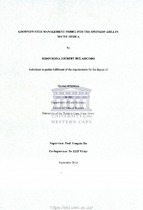| dc.description.abstract | The thesis investigates the potential of the Rietfontein and Spitskop aquifer to meet a demand of 1000 m3/d (12 Lis) as an alternative water resource for the Rietfontein and Spitskop Community. Increasing demand for clean and hygienic drinking water puts more pressure on one of our most valuable resources and supplying all communities with surface water is an extremely difficult and costly task in rural areas like Rietfontein and Spitskop in South Africa. Therefore it is necessary that interim water supplies be found from local aquifers and be utilized to address water supply challenges. Groundwater may serve as a short-term and an interim water supply which may be useful during future dry periods. Abstraction of groundwater is sensitive to recharge. Due to semi-arid conditions in Rietfontein and Spitskop area, there is high rainfall variation and disparity each year. During the research, hydrocensus was carried out. Water samples for chemistry analysis were taken. Literature review and pumping test data was utilized from the previous studies done by different consultants (Botha, 2000, Vivier and Pretorius, 2003). A numerical groundwater flow model for the local aquifers in the area and surroundings was constructed focusing on
recharge and abstraction scenarios for the water supply from the local aquifers. For Rietfontein and Spitskop area, the mean annual precipitation (MAP) is 617mm/year. To be assured and rational in determining aquifers ability to meet the required demand a recharge
with ninety-five (95th ) percentile was recommended, which estimates the MAP of 308mm/year which is 50% lower than the average MAP of 617mm/year. For a period of ninety six (96) years, the data indicates a severe drought occurred four (4) times where the rainfall was even lower than 95th percentile level of assurance of recharge estimated. This gives a comprehensible indication that average mean is not ideal or steadfast stature when building a water supply numerical groundwater flow modelling. These aquifers can only be exploited and managed if a reliable method can be obtained to estimate their long-term sustainable potential, since the sustainable potential of these aquifers to supply the communities is dependent upon the recharge from rainfall. The results from a numerical groundwater flow model indicated that a combined potential from the local aquifer from eighteen (18) boreholes is sufficient to meet the required demand and a total of 2600m3 Id can potentially be abstracted from the aquifer. With ninety-five (95th ) percentile recharge rate of 308mm/year a numerical groundwater flow model shows that the rate of abstraction is 80% far less than recharge, which gives high level of assurance in terms of local aquifer water supply demand. The abstraction of the boreholes confirmed by a numerical groundwater flow model shows the least impact on the surrounding aquifer for an extended period of time. In the event of drought, the boreholes will see a decline in water level after two (2) months of pumping local aquifer. The water level will decline steadily from two (2) months to two (2) years with a change in water levels of up to 40m. The impact of the drought is minimal compared to recharge rate, which verifies less depletion of the aquifer. The local aquifer
shows the potential of 3MLld can be supplied to the communities with an assurance level of 95th percentile of rainfall. Reliable quantification of groundwater recharge rate remains the main challenges the hydrologist experienced and further research is essential for improvement of groundwater management for the area concerned. | en_US |

